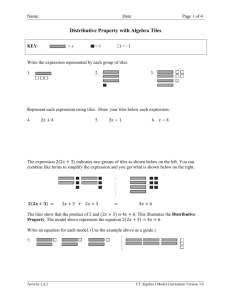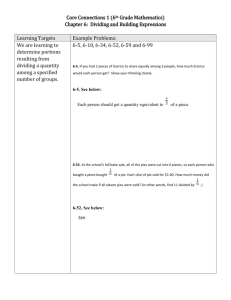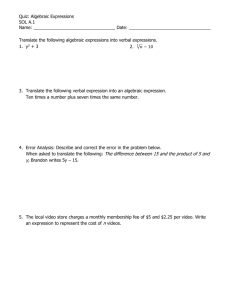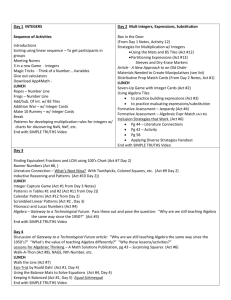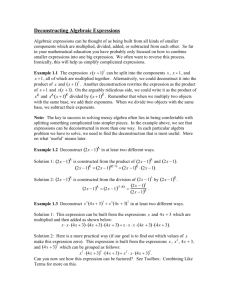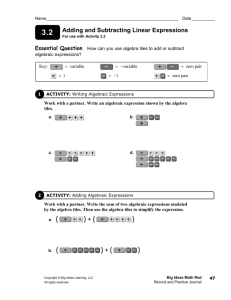DISTRIBUTIVE PROPERTY LESSON
advertisement
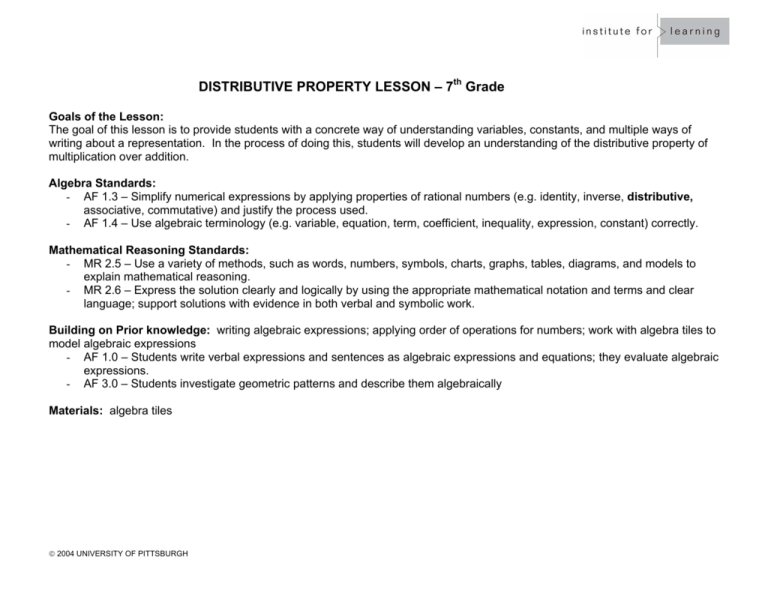
DISTRIBUTIVE PROPERTY LESSON – 7th Grade Goals of the Lesson: The goal of this lesson is to provide students with a concrete way of understanding variables, constants, and multiple ways of writing about a representation. In the process of doing this, students will develop an understanding of the distributive property of multiplication over addition. Algebra Standards: - AF 1.3 – Simplify numerical expressions by applying properties of rational numbers (e.g. identity, inverse, distributive, associative, commutative) and justify the process used. - AF 1.4 – Use algebraic terminology (e.g. variable, equation, term, coefficient, inequality, expression, constant) correctly. Mathematical Reasoning Standards: - MR 2.5 – Use a variety of methods, such as words, numbers, symbols, charts, graphs, tables, diagrams, and models to explain mathematical reasoning. - MR 2.6 – Express the solution clearly and logically by using the appropriate mathematical notation and terms and clear language; support solutions with evidence in both verbal and symbolic work. Building on Prior knowledge: writing algebraic expressions; applying order of operations for numbers; work with algebra tiles to model algebraic expressions - AF 1.0 – Students write verbal expressions and sentences as algebraic expressions and equations; they evaluate algebraic expressions. - AF 3.0 – Students investigate geometric patterns and describe them algebraically Materials: algebra tiles © 2004 UNIVERSITY OF PITTSBURGH Phase S E T U P Action Prior to the lesson: - Students should understand the algebra tile model. - Students should be set up to work with a partner for this lesson. SETTING UP THE LESSON If necessary, remind students what the rectangle and square algebra tiles represent. You might want to have students model and explain 3 times 2, then 3x, and then 3x + 2. Display the representation and ask students to tell you what the representation shows. - What does the display show? - How would you write about the display mathematically? - Which is more? Comments Students should understand that a rod represents “x”, “n”, etc. Talk about a rod representing an unknown amount, a set of units. A square represents “1” represents “-1” SETTING UP THE LESSON 6 units 3 times 2 3x 3x + 2 3 groups of 2 3 x’s 3 x’s plus 2 units _____________________________ How might students respond to the set-up of the lesson? ________________________________________ Write 2x + 5 on the overhead or chalkboard and ask students to represent the expression with their algebra tiles. - How would you describe the display? Write as many different ways as possible and be prepared to explain how they are all names for the same set. © 2004 UNIVERSITY OF PITTSBURGH E X P L O R E Represent the expression 3(2x + 5) on the overhead using algebra tiles. Do not draw a circle around the groups of 2x + 5. Ask students: As students are finding all of the ways to represent and write about 3(2x + 5), how might I assess and advance student learning as I am circulating during small group problem solving? As you circulate ask students the following questions to assess their understanding of the task: − How would you describe the set displayed on the overhead? How would you record that mathematically? − Tell me about your expression and how it matches with the representation. − Can you write about the set another way? How is this way different from the first way you came up with? − How is 3(2x + 5) = (2x + 5) + (2x + 5) + (2x + 5)? − How is 3(2x + 5) = 6x + 15? − How are the three expressions equivalent? Can you write about the set in either of these ways? − Write a sentence that explains how the two expressions are equivalent. − I wrote (3 • 2x) + (3 • 5). Am I allowed to write this? How do you know? − If I had the expression 3(2x + 5) but not the algebra tiles how would I know that it is equal to 6x + 15? Possible Responses Students might say and show: - 3(2x + 5) means 3 groups of 2x + 5 - (2x + 5) + (2x + 5) + (2x + 5) - 6x + 15 Students might move the blocks to show that the two ways of looking at the blocks are really the same set of blocks. 6x + 15 (3 • 2x) + (3 • 5) What might I hear from students that lets me know that they understand the relationship between the expressions and the representations and the expressions? - Students will say that 3(2x + 5) is talking about 2x + 5 as a group and there are three of these groups; whereas (2x + 5) + (2x + 5) + (2x + 5) talks about each group separately. - Students might say that there are 6x’s in each representation or each expression. One representation has all of the x’s together and the other has them spread out. Using the language of spread out to make the connection to the idea of distribution. 2x + 5 is distributed three times. © 2004 UNIVERSITY OF PITTSBURGH What misconceptions might students have when working on the task? - Students might write 6x + 5 instead of 6x + 15. S H A R E, D I S C U S S, A N D A N A L Y Z E E X P L O R E FACILITATING WHOLE GROUP DISCUSSION What might I see or hear that lets me know that students understand the concepts? Ask students if the two representations are equal and if so how they know. Ask students: - How did you write about the tiles and why did you write your expression? - Are these expressions 3(2x + 5) = 6x + 15 equivalent? - Can I write (3 • 2x) + (3 • 5)? How is this shown in the model? How did someone go from 3(2x + 5) to (3 • 2x)+ (3 • 5)? - This (3 • 2x)+ (3 • 5) is called the distributive property. Can anyone say why this is called the distributive property? - Ask students to put another student’s explanation in their own words. - Ask students to agree or disagree with a student’s statement and then provide an explanation WHY they agree or disagree. PART II Represent 4(3x + 2) on the overhead. Ask students to write about the set as many ways as possible. Engage in a similar discuss as above. Write the expression 3(4x + 2) on the board and ask students to represent the set as many ways as possible. © 2004 UNIVERSITY OF PITTSBURGH What misconceptions might students have when working on the task? If the student does not use the algebra tiles but attempts to simplify 3(2x+5) the expression formally, he may make the common mistake of only multiplying the first term by 3. Ask him to show you the expression with the tiles. FACILITATING WHOLE GROUP DISCUSSION What might I see or hear that lets me know that students understand the concepts? These types of questions provide students with opportunities to work toward standard MR 2.6 – Express the solution clearly and logically by using the appropriate mathematical notation and terms and clear language; support solutions with evidence in both verbal and symbolic work. Students are working toward this standard if they: - indicate that the expressions are equivalent. They may say that 3(2x + 5) means 3 groups of “2x + 5” and that 6x + 15 means 6x’s and 15 1’s. - say that the expressions are equivalent since they represent equivalent representations of algebra tiles. The students can make connections between the representations or the symbolic representations and concrete items. - As students talk about the 3 sets of 2x or the 6x, you might call the 2 and the 6 the coefficient. Students are working toward standard 1.3 – Simplify numerical expressions by applying properties of rational numbers (e.g. identity, inverse, distributive, associative, commutative) and justify the process used if they can explain that 3(2x + 5) = 3 • 2x + 3 • 5 because 3 groups of each of the items in the parentheses are needed. They might say that three of each set in the parentheses. They should say that the two expressions are also equal to 6x + 15. PART II The next expression involves work with a negative number. Represent the expressions 2(2x – 1) on the overhead with algebra tiles. Ask students to represent the set in other ways and to write expressions that describe the set. Error! PRIVATE PROBLEM SOLVING Ask students the following questions: - Are the two representations equivalent? Why or why not? Write expressions that describe the two representations. FACILITATING SMALL GROUP PROBLEM SOLVING What do I do if students have difficulty getting started? - You might suggest rearranging or regrouping the tiles. FACILITATING SMALL GROUP PROBLEM SOLVING What do I do if students have difficulty getting started? If students are struggling and you ask them to describe the representation then ask them to record their description mathematically. For example, a student might say I see two strips. Revoice this as 2x and have the student record his description. Students should write 2(2x – 1) = 4x – 2 How might I assess and advance student learning as I am circulating during small group problem solving? How might I assess and advance student learning as I am circulating during small group problem solving? Ask students: - What do you see (in the representation)? Encourage students to record their description mathematically. - Are the two representations equivalent? If so, explain how they are equivalent. - Write a written expression for each and prove that they are equivalent. - Why do we write 4x – 2 not plus two? Students should say that 2 groups of “2x” plus 2 groups of “-1” is the same as 4x + -2 or 4x - 2. Record (2 • 2x) + (2 • -1) What misconceptions might students have when working on the task? - Students might write 2(2x+1) instead of 2(2x-1) - Students might write 4x + 2 instead of 4x – 2 as an expression © 2004 UNIVERSITY OF PITTSBURGH What misconceptions might students have when working on the task? Students might record 2(2x + 1) instead of 2(2x – 1) if they fail to recognize the negative integer. Students might say “plus 2” instead of “-2” if they fail to remember a dark tile represents a negative amount. Ask the student to show you the + 2 blocks. They might show you the two dark tiles. If they do then say S H A R E, D I S C U S S, FACILITATING WHOLE GROUP DISCUSSION What might I see or hear if students understand the concepts? Ask students if the two representations are equal and if so how they know. Ask students: - What expression can be written for each set? Are these expressions 2(2x - 1) = 4x - 2 equivalent? Why or why not? We have just done the distributive property. What does this mean? A N D A N A L Y Z E H O M E W O R K these are negative tiles. FACILITATING WHOLE GROUP DISCUSSION What might I see or hear if students understand the concept? Students have had opportunities to work to standard MR 2.6 – Express the solution clearly and logically by using the appropriate mathematical notation and terms and clear language; support solutions with evidence in both verbal and symbolic work. Students are working toward this standard if they: - indicate that the expressions are equivalent. - write the expressions 2(2x - 1); (2 •2x) + (2 • -1); and 4x – 2 - say that 2(2x – 1 ) means 2 groups of “2x - 1” and that 4x - 2 means 4 x’s and 2 -1’s. - say that the expressions are equivalent since they represent equivalent representations of algebra tiles. Students are working toward standard 1.3 – Simplify numerical expressions by applying properties of rational numbers (e.g. identity, inverse, distributive, associative, commutative) and justify the process used if they can explain that 2(2x -1) = (2 •2x) + (2• -1) because 2 of each of the items in the parentheses are needed since we are multiplying. They should say that the two expressions are also equivalent to 4x - 2. HOMEWORK: A. Ask students to model and apply the distributive property by using graph paper for the following problems: a. 2(4 + 3x) b. (x – 3)4 c. 3(-2x + 1) a. 8 + 6x B. Write an expression for the algebra tiles below. Then regroup the tiles and write another expression. Explain why the two representations are equivalent. Show the relationship between the models for each representation. B. 6x + 3 = 3(2x + 1) © 2004 UNIVERSITY OF PITTSBURGH b. 4x – 12 c. -6x + 3

